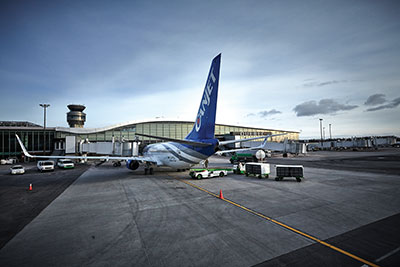
Features
Airports
At the gate: Perfecting the information game
Quebec City’s Jean Lesage International Airport holds the distinction of becoming the first airport in the world to implement a data transformation service.
January 10, 2014 By Brian Dunn
Quebec City’s Jean Lesage International Airport holds the distinction of becoming the first airport in the world to implement a data transformation service. The service allows the airport to have data from multiple airlines seamlessly incorporated into its airport management system.
 |
|
| Effective use of data is most apparent during times of disruption such as inclement weather. Photo: Aéroport de Québec
|
The new community messaging service is provided by SITA, which bills itself as the world’s leading specialist in air transport communications and information technology. It allows the airport to automatically process information directly from all the airlines’ operational messages for use in airport resource planning and allocation.
Actual arrival and departure times, passenger counts and load figures from Movement and Load/Distribution messages are now all seamlessly incorporated using XML into SITA’s Airport Management System. XML (Extensible Markup Language) is a markup language that defines a set of rules for encoding documents in a format that is both human-readable and machine-readable.
“A huge volume of data is available to airports from the airlines, but traditionally it is tied up in a complex and un-harmonized system of formats and applications,” explained Marc-André Bédard, manager of strategic planning at Jean Lesage airport. “By using SITA’s next generation messaging service, we can take the various feeds from the airlines that fly to Quebec Airport and have them in modern XML format. The information then flows easily into our management systems for immediate processing.”
Bédard said the airport needs the information about actual flight times, loads, and flight delays to allow it to allocate facilities, resources and services in the most effective way. The information can be used in a number of ways. For example, if an airport or ground handler knows an arriving flight has a large number of passengers and load, it can allocate more resources to manage the aircraft and divert staff and equipment from flights that require less support.
Effective use of data is most apparent during times of disruption such as inclement weather when an airport can make decisions that take into account all factors as it relocates things like manpower, equipment and gates.
A three-month trial at the Quebec airport demonstrated the efficiencies of the system, which prevents delays and errors through manual processing. It also prevents the airport having to develop and maintain expensive and complicated in-house messaging interfaces, according to Rukmini Glanard. In addition to the benefits it brings to overall operations, the service has also been shown to improve the accuracy it brings to the airport’s reporting and billing processes, he added.
Quebec’s airport serves 10 airlines operating 350 flights a week to 54 destinations. The airport will receive about 400,000 messages in a single year in a variety of daily operations and decisions. The airport became the launch customer for the system because it already had an airport management system from SITA and the data transformation service ties into it.
“The data system is designed for small- and medium-size airports, because larger airports tend to have more in-house IT capabilities,” explained Dominique El Bez, director of messaging and mobility solutions line at SITA. “The cost consists of a monthly service fee and a small setup fee and pay as you go fee. There is no up-front investment or development costs.”
The cost savings are realized by eliminating complex technology to access information and by simplifying the way data is recorded.
One area where the service is beneficial is helping passengers with reduced mobility when they deplane.
“It is important staff are aware when passengers need help on the ground. I’ve seen glitches when the staff are not aware because they don’t have the right information or no information at all,” noted El Bez.
SITA Community Messaging handles more than 30 billion operational messages per year through more than 2,400 organizations within the air transport community. The service’s unique presence at airports worldwide gives it unprecedented access to operational data from the vast majority of airlines, airports and ground-handlers.
Brian Dunn is a Wings writer and columnist.